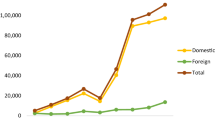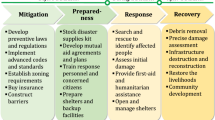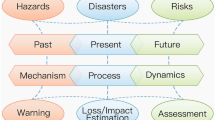Abstract
Due to the climate change and the rapid progress of urbanization, extreme weather disasters such as urban rainstorm and waterlogging are frequent. Therefore, how to find the waterlogging points in the presence of disasters and how to optimize the distribution of urban emergency logistics and reduce the negative impact of disasters have become a hot and difficult issue for government departments and scholars. First of all, the idea and method of using the big data of microblogging to obtain urban rainstorm and waterlogging disasters and public sentiment are put forward. In addition,this thesis constructed the location-routing problem model of urban emergency logistics in the situation of rainstorm and waterlogging disaster, and found out the dynamic emergency distribution path of Nanjing in the situation of waterlogging disaster by using NSGA-III algorithm. Research shows that the risk management of urban rainstorm and waterlogging disasters, together with social media data, is a feasible way to obtain on-site data of disasters and carry out risk assessment of disasters. At the same time, the emergency logistics location-positioning model and algorithm can provide a reference for similar disaster emergency logistics distribution network and the conclusion can provide empirical reference for cities to cope with rainstorm and waterlogging disasters.










Similar content being viewed by others
Notes
First of all, the Yangtze River region experiences frequent heavy rainstorms. As the capital of six dynasties in ancient China, the capital of Jiangsu province and one of the cities with the largest population in the Yangtze River region, Nanjing city has been suffering from heavy rainstorms for a long time. For instance, the heavy rainstorm from June, 2016 to July, 2016 imposed great influence on Nanjing. The rainfall in 10 h on June 10th broke the record of daily rainfall within a century. The heavy rainstorm did not stop until June 27th, causing many regions submerged and subway outrage of multiple lines. Second, since the data of microlog and road traffic of the present paper are all from Nanjing, the paper chooses Nanjing as the case for research.
The disaster index came from Cheng et al. (2011) and the weights were determined by 3 rainstorm disaster experts of Jiangsu meteorological bureau.
References
Ahmadi, M., Seifi, A., & Tootooni, B. (2015). A humanitarian logistics model for disaster relief operation considering network failure and standard relief time: A case study on San Francisco district. Transportation Research Part E,75, 145–163.
Asgari, N., Rajabi, M., Jamshidi, M., et al. (2017). A memetic algorithm for a multi-objective obnoxious waste location-routing problem: A case study. Annals of Operations Research,250, 279–308. https://doi.org/10.1007/s10479-016-2248-7.
Bandyopadhyay, S., & Bhattacharya, R. (2013). Solving multi-objective parallel machine scheduling problem by a modified NSGA-II. Applied Mathematical Modelling,37(10–11), 6718–6729.
Burkart, C., Nolz, P. C., & Gutjahr, W. J. (2016). Modelling beneficiaries’choice in disaster relief logistics. Annals of Operations Research. https://doi.org/10.1007/s10479-015-2097-9.
Chang, K. L., Zhou, H., Chen, G. J., & Chen, H. Q. (2017). Multiobjective location routing problem considering uncertain data after disasters. Discrete Dynamic in Nature and Society,3, 1–7.
Chen, P., Zhang, J., Sun, Y., & Liu, X. (2016). Wargame simulation theory and evaluation method for emergency evacuation of residents from urban waterlogging disaster area. International Journal of environmental Research & Public Health,13(12), 1260.
Cheng, L. H., Hong, T., Zhou, T. G., et al. (2011). Evaluation method of natural disaster intensity and its application: A research based on comprehensive disaster condition index. Journal of Natural Disasters,20(1), 46–50.
Choi, S., & Bae, B. (2015). The real-time monitoring system of social big data for disaster management. In Computer science and its applications (pp. 809–815). Berlin Heidelberg: Springer.
Cooper, L. (1972). The transportation-location problem. Operations Research,20, 94–108.
Cooper, L. (1976). An efficient heuristic algorithm for the transportation-location problem. Journal of Regional Science,16(3), 309–315.
Dalfard, V. M., Kaveh, M., & Nosratian, N. E. (2013). Two meta-heuristic algorithms for two-echelon location-routing problem with vehicle fleet capacity and maximum route length constraints. Neural Computing and Applications,23(7–8), 2341–2349.
Deb, K., Agrawal, S., Pratap, A., et al. (2000). A fast elitist nondominated sorting genetic algorithm for multi-objective optimization: NSGA-II. In Proceedings of the parallel problem solving from nature VI Conf, Paris, pp. 849–858.
Deng, J. L., Shen, S. L., & Xu, Y. S. (2016). Investigation into pluvial flooding hazards caused by heavy rain and protection measures in Shanghai, China. Natural Hazards,83, 1301–1320. https://doi.org/10.1007/s11069-016-2369-y.
Duan, P. Y., Wang, Y., Sang, H., et al. (2016). A developed NSGA-II Algorithm for multi-objective chiller loading optimization problems. In D. S. Huang, V. Bevilacqua, & P. Premaratne (Eds.), Intelligent computing theories and application. ICIC 2016. Lecture Notes in Computer Science (Vol. 9771). Cham: Springer.
Fallah-Mehdipoura, E., Haddad, O. B., & Tabari, M. M. R. (2012). Extration of decision alternatives in construction management projects: Application and adaptation of NSGA-II and MOPSO. Expert Systems with Applications,39, 2794–2803.
Feng, Y. Y., Wu, I. C., & Chen, T. L. (2017). Stochastic resource allocation in emergency departments with a multi-objective simulation optimization algorithm. Health Care Management Science,20(1), 55–75.
Han, Y. Y., Guan, X. H., & Shi, L. Y. (2011). Optimization based method for supply location selection routing in large-scale emergency material delivery. IEEE Transactions on Automation Science and Engineering,8(4), 683–693.
Herfort, B., Brenning, A., & Zipf, A. (2015). A geographic approach for combining social media and authoritative data towards identifying useful information for disaster management. International Journal of Geographical Information Science,29(4), 667–689.
Hou, W. Y. (2013). An analysis of public opinion evolution of microblogging in group incident. Harbin Institute of Technology.
Hu, S. L., Han, C. F., & Meng, L. P. (2015). A scenario planning approach for propositioning rescue centers for urban waterlog disasters. Computers & Industrial Engineering,87, 425–435.
Jotshi, A., Gong, Q., & Batta, R. (2009). Dispatching and routing of emergency vehicles in disaster mitigation using data fusion. Socio-Economic Planning Sciences,43(1), 1–24.
Kalaivani, L., Subburaj, P., & Iruthayarajan, M. W. (2013). Speed control of switched reluctance motor with torque ripple reduction using non-dominated sorting genetic algorithm (NSGA-II). Electrical Power and Energy Systems,53, 69–77.
Kaur, H., & Singh, S. P. (2016). Sustainable procurement and logistics for disaster resilient supply chain. Annals of Operations Research. https://doi.org/10.1007/s10479-016-2374-2.
Khalipourazari, S., & Khamseh, A. A. (2017). Bi-objective emergency blood supply chain network design in earthquake considering earthquake magnitude: A comprehensive study with real world application. Annals of Operations Research. https://doi.org/10.1007/s10479-017-2588-y.
Li, S. Y., & Zhou, H. J. (2014). Optimization model of fuzzy location-routing problem of victim search in flood disaster. Journal of Chemical and Pharmaceutical Research,6(6), 2080–2085.
Li, Q., Zhu, H. M., & Yang, D. C. (2013). The evolution model of public opinion topic in microblogging network. New Technology of Library and Information Service,12, 74–80.
Liu, Y., Du, M. Y., Jing, C. F., & Cai, G. Y. (2015). Design and implementation of monitoring and early waring system for system for urban roads waterlogging. In Computer and computing technologies in agriculture VIII, pp 610–615.
Ma, Z. J. (2006). China’s natural disasters and disaster mitigation countermeasures (2). Journal of Disaster Prevention Science and Technology,4, 1–5.
Mao, D. H. (2000). Assessment and analysis of flood-waterlogging disaster condition in Dongting lake region. Journal of Natural Disasters,3, 46–53.
Matsumoto, T. (2010). Real-time multi-sensor localisation and mapping algorithms for mobile robots. Flinders University Computer Science Engineering & Mathematics.
Mete, H. O., & Zabinsky, Z. B. (2010). Stochastic optimization of medical supply location and distribution in disaster management. International Journal of Production Economics,126(1), 76–84.
Mohapatra, P., Nayak, A., Kumar, S. K., & Tiwari, M. K. (2015). Multi-objective process planning and scheduling using controlled elitist non-dominated sorting genetic algorithm. International Journal of Production Research,53(6), 1712–1735.
Moshref-Javadi, M., & Lee, S. (2016). The latency location-routing problem. European Journal of Operational Research,255(2), 604–619.
Neppalli, V. K., Caragea, C., Squicciarini, A., et al. (2017). Sentiment analysis during Hurricane Sandy in emergency response. International Journal of Disaster Risk Reduction,21, 213–222.
Pasandideh, S. H. R., Niaki, S. T. A., & Sharafzadeh, S. (2013). Optimizing a bi-objective multi-product EPQ model with defective items, rework and limited orders:NSGA-II and MOPSO algorithms. Journal of Manufacturing Systems,32, 764–770.
Pranmudita, A., Taniguchi, E., & Qureshi, A. G. (2014). Location and routing problems of debris collection operation after disasters with realistic case study. Procedia-Social and Behavioral Sciences,125, 445–458.
Preethi, P. G., Uma, V., & Kumar, A. (2015). Temporal sentiment analysis and causal rules extraction from Tweets for event prediction. Procedia Computer Science,48, 84–89.
Rabiee, M., Zandieh, M., & Ramezani, P. (2012). Bi-objective partial flexible job shop scheduling problem: NSGA-II, NRGA, MOGA and PAES approaches. International Journal of Production Research,50(24), 7327–7342.
Rahman, S. U., & Smith, D. K. (2000). Use of location-allocation models in health service development planning in developing nations. European Journal of Operational Research,123(3), 437–452.
Rath, S., & Gutjahr, W. J. (2014). A math-heuristic for the warehouse location-routing problem in disaster relief. Computers & Operation Research,42, 25–39.
Sakaki, T., Okazaki, M., & Matsuo, Y. (2010). Earthquake shakes Twitter users: Real-time event detection by social sensors. In: Rappa, et al. (Eds.), Proceedings of the 19th international conference on World Wide Web (WWW) (pp. 851–860). New York: ACM.
Song, M., & Du, Q. (2017). Analysis and exploration of damage-reduction measures for flood disasters in China. Annals of Operations Research,3, 1–16.
Song, M., Peng, J., Wang, J., & Zhao, J. (2017). Environmental efficiency and economic growth of China: A ray slack-based model analysis. European Journal of Operational Research. https://doi.org/10.1016/j.ejor.2017.03.073.
Srinivas, N., & Deb, K. (1995). Multiobjective function optimization using nondominated sorting genetic algorithms. Evolutionary Computation,2(3), 221–248.
Su, B. N., Huang, H., & Li, Y. (2016). Integrated simulation method for waterlogging and traffic congestion under urban rainstorms. Natural Hazards,81, 23. https://doi.org/10.1007/s11069-015-2064-4.
Tayal, A., & Singh, S. P. (2017). Formulating multi-objective stochastic dynamic facility layout problem for disaster relief. Annals of Operations Research. https://doi.org/10.1007/s10479-017-2592-2.
Ting, C. G., & Chen, C. H. (2013). A multiple ant colony optimization algorithm for the capacitated location routing problem. International Journal of Production Economics,141, 34–44.
Wang, H. J., Du, L. J., & Ma, S. H. (2014). Multi-objective open location-routing model with split delivery for optimized relief distribution in post-earthquake. Transportation Research Part E,69, 160–179.
Wang, L. Z., Wang, D. W., Wu, S. L., et al. (2015). Study on multi-depots vehicle transshipment scheduling problem and its genetic algorithm and ant colony algorithm hybrid optimization. In E. Qi, J. Shen, & R. Dou (Eds.), Proceedings of the 22nd international conference on industrial engineering and engineering management. Paris: Atlantis Press.
Wei, Y., & Özdamarb, L. (2007). A dynamic logistics coordination model for evacuation and support in disaster response activities. European Journal of Operational Research,179(3), 1177–1193.
Wu, T. H., Low, C., & Bai, J. W. (2002). Heuristic solutions to multi-depot location-routing problems. Computers & Operations Research,29(10), 1393–1415.
Wu, Z. D., & Zhao, Y. (2012). Emergency logistics decision support system based on data mining and WebGIS technology. Journal of Shenyang Normal University (Natural Science Edition),30(2), 227–231.
Xu, J. H., Chu, J., Nie, G., et al. (2015). Earthquake disaster information extraction based on location microblog. Journal of Natural Disasters,5, 12–18.
Yang, S. N. (2014). Research on method of network public opinion monitoring of emergency based on micro-blog. Dalian University of Technology.
Yang, Y. (2014). Research on the emergency logistics location-path of urban emergency. Harbin Institute of Technology (in China).
Yu, V. F., Lin, S. W., Lee, W., & Ting, C. J. (2010). A simulated annealing heuristic for the capacitated location routing problem. Computers & Industrial Engineering,58(2), 288–299.
Yu, S. W., Zhang, S. H., Gao, S. W., & Yang, J. (2017). A multi-objective decision model for investment in energy and mission reductions in coal mining. European Journal of Operational Research,260(1), 335–347.
Yan Q., Huang C., Zhang P., et al. (2010). Microblogging after a major disaster in China: A case study of the 2010 Yushu earthquake. In ACM Conference on Computer Supported Cooperative Work, CSCW 2011, Hangzhou, China, March. DBLP., pp 25–34.
Zheng, Y. (2014). Emotional analysis of Chinese microblogging based on emotional dictionary. Sun Yat-sen University.
Zhou, Y. W., Liu, J., Zhang, Y. T., & Gan, X. H. (2017). A multi-objective evolutionary algorithm for multi-period dynamic emergency resource scheduling problems. Transportation Research Part E,99, 77–95.
Zhou, F. R., Miao, D. Q., Zhang, Z. F., et al. (2012). News topic detection approach on Chinese microblog. Computer Science,1, 138–141.
Zhou, Y. M., Yang, J. N., & Yang, A. M. (2013). A method on building Chinese sentiment lexicon for text sentiment analysis. Journal of Shandong University,6, 27–33.
Acknowledgements
This research was supported by: The Natural Science Foundation of China (91546117, 71373131); Key Project of National Social and Scientific Fund Program (16ZDA047); The Ministry of Education Scientific Research Foundation for the returned overseas students (No. 2013-693, Ji Guo). This research was also supported by the Priority Academic Program Development of Jiangsu Higher Education Institutions and the Flagship Major Development of Jiangsu Higher Education Institutions.
Author information
Authors and Affiliations
Corresponding author
Rights and permissions
About this article
Cite this article
Wu, X., Cao, Y., Xiao, Y. et al. Finding of urban rainstorm and waterlogging disasters based on microblogging data and the location-routing problem model of urban emergency logistics. Ann Oper Res 290, 865–896 (2020). https://doi.org/10.1007/s10479-018-2904-1
Published:
Issue Date:
DOI: https://doi.org/10.1007/s10479-018-2904-1




